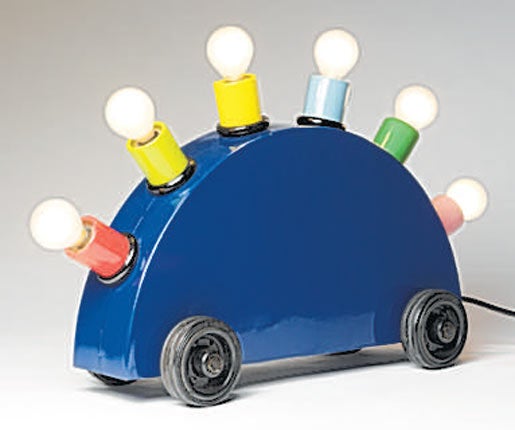Postmodernism - Style and Subversion 1970-1990, Victoria & Albert Museum, London
Bright ideas abound at the V&A's lucid show

Your support helps us to tell the story
From reproductive rights to climate change to Big Tech, The Independent is on the ground when the story is developing. Whether it's investigating the financials of Elon Musk's pro-Trump PAC or producing our latest documentary, 'The A Word', which shines a light on the American women fighting for reproductive rights, we know how important it is to parse out the facts from the messaging.
At such a critical moment in US history, we need reporters on the ground. Your donation allows us to keep sending journalists to speak to both sides of the story.
The Independent is trusted by Americans across the entire political spectrum. And unlike many other quality news outlets, we choose not to lock Americans out of our reporting and analysis with paywalls. We believe quality journalism should be available to everyone, paid for by those who can afford it.
Your support makes all the difference.It starts, as it must, with a theatrical destruction. A designer photographs his modernist chair on fire in a canyon, creating an image in which a symbolic token of modernism – high-minded, utopian, and well-mannered – is spectacularly immolated. The ruin is, deviously, as intriguing as the design object itself. It's appropriate that the V&A have opened Postmodernism this way, as postmodernism is indelibly associated with what came before. Modernism: the grand narrative, artistic innovation, the drive to create a better world, to reveal truth in art, materials, life. Postmodernism says: to hell with that. What's truth anyway? Why must we accept it? And who wrote fun out of the picture?
These are good questions, but postmodernism as a term is slippery, "toxic" even, as described in the exhibition catalogue. It quickly became associated with the knowing, ironic, cool, even cold. Take a 19th century Chantilly cabinet, with its ostentatious carved surface and golden fittings, and stick some shiny, blue and white lacquered stripes on it, as Pieter De Bruyne did in 1975. Ecstatic wrongness. Architects took falsely ruined Roman columns and placed them next to poppy squiggles. Gleeful subversion.
Curiously, however, for a movement so associated with the arched eyebrow, there's something punkish, optimistic even, about all this, which is well brought out by the curators. Two clips from Ridley Scott's Blade Runner are present, in which we see a tantalising mess of neons, androids and mannequins, the natural and the artificial in combine. The many chairs, cabinets and teapots associated with the Italian Memphis group are like fantasy items: spots, stripes, pastels. The unfixed sexuality in the performances of Leigh Bowry and Michael Clark, an MTV wall. Devo, Kraftwerk, Grace Jones, the Eurythmics. Here is a generation, as the narrator of Derek Jarman's The Last of England puts it: "emerging from the chrysalis all scarlet and turquoise as death's head from chipped plants".
The narrative in this exhibition is lucid, no mean feat for a movement that arguably touched every corner of culture. Opening the last section – Money – is an Andy Warhol dollar sign screenprint from 1981. Postmodernist designers embraced cash and entered a period of ostentation, marketed at the yuppie. What had once seemed subversive and anti-authoritarian, now answered to one master – money.
Things become unbearably melancholy looking at a teapot so overdesigned it has become simply a cipher for wealth and taste, an emotional atmosphere underpinned by Philip Glass's soundtrack to 'Koyaanisqatsi: Life Out of Balance' which rings coldly around the room. This is compounded by the exhibition's coda: men and women in suits falling through the sky from New Order's "Bizarre Love Triangle" video ("why can't we be ourselves like we were yesterday") which, combined with Robert Longo's drawings of 'Men in Cities', who appear to be convulsing, evoke memories of 9/11. Everything is jumpy, confused, electrified. Who knew that postmodernism would end up with its own ruins? Yes, this is an exhibition of style and there is much more that could be considered here Jean Cocteau warned about the "look" of the new, writing that "the young people visiting our ruins see nothing but a style". True enough. But perhaps that's a defensible approach to postmodernism.
Tomorrow to 15 January (020 7942 2000)
Join our commenting forum
Join thought-provoking conversations, follow other Independent readers and see their replies
Comments